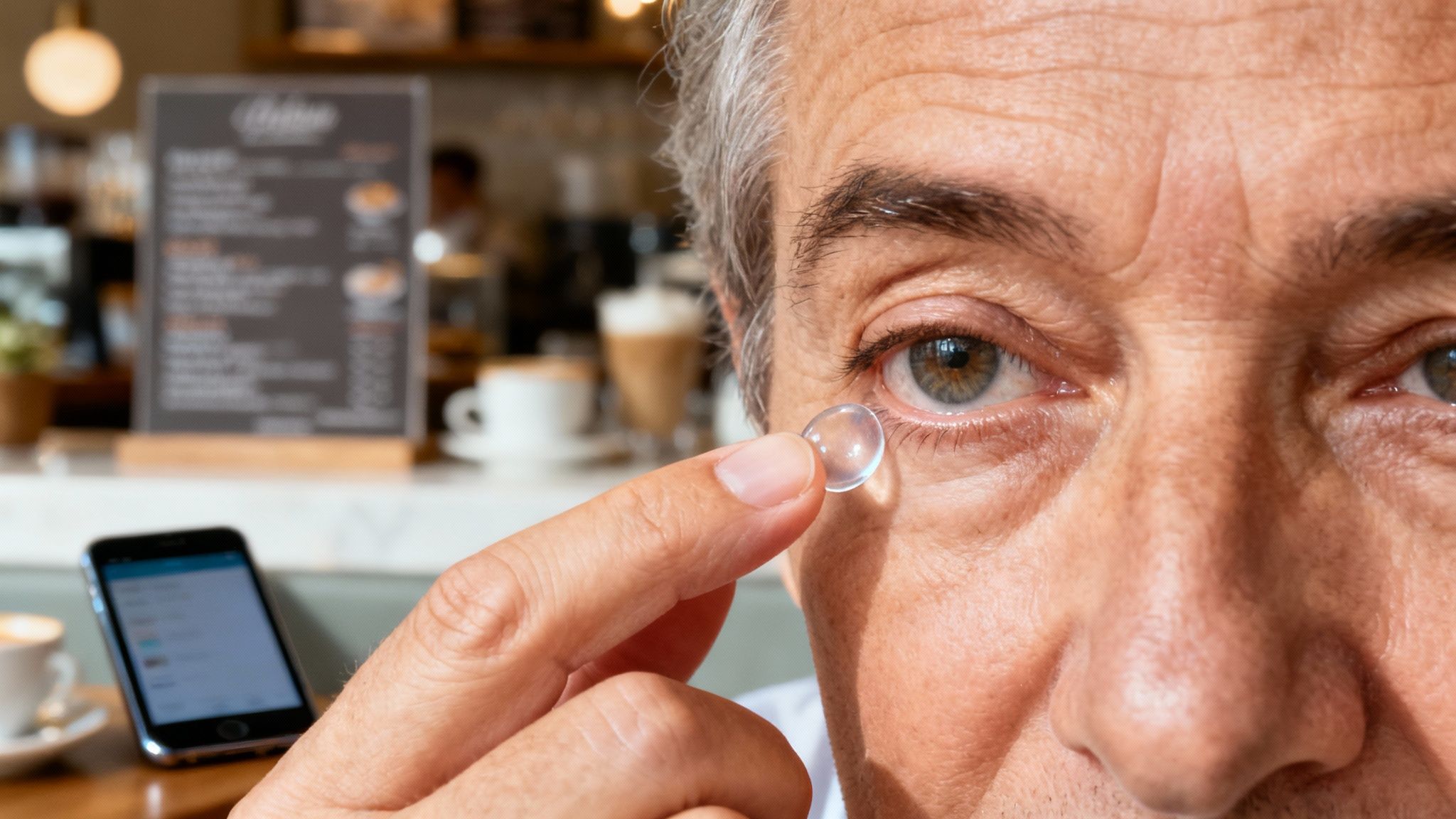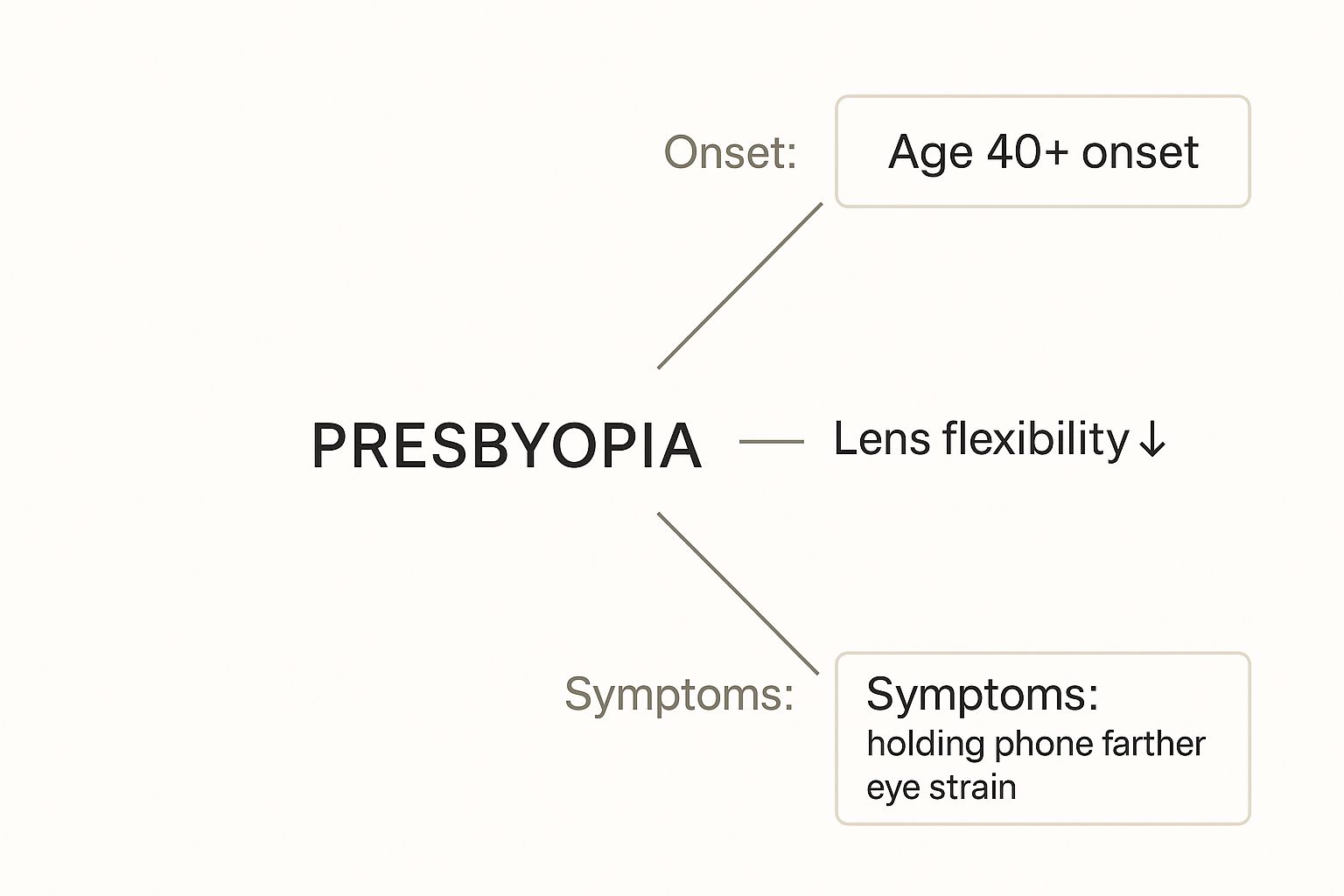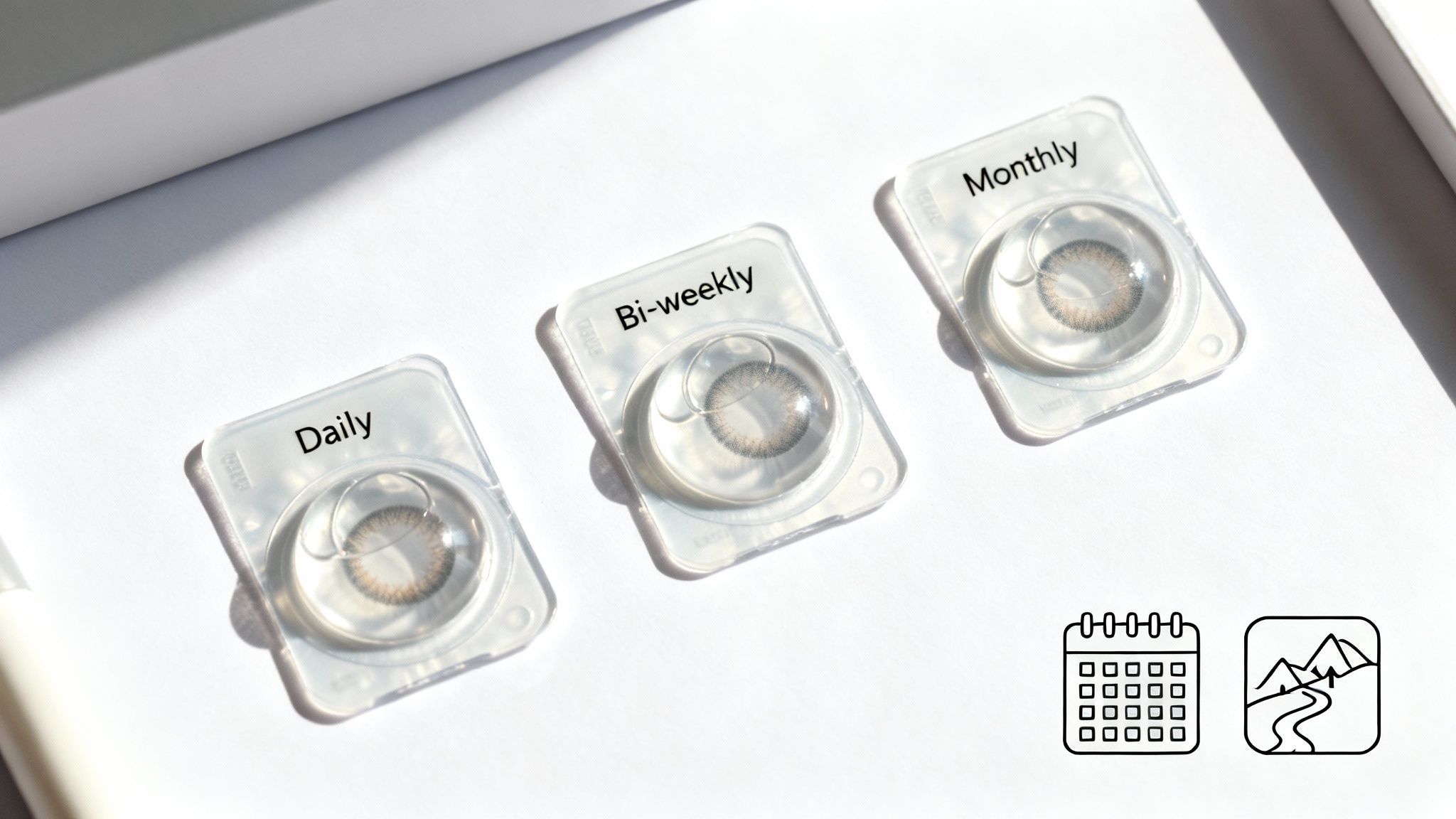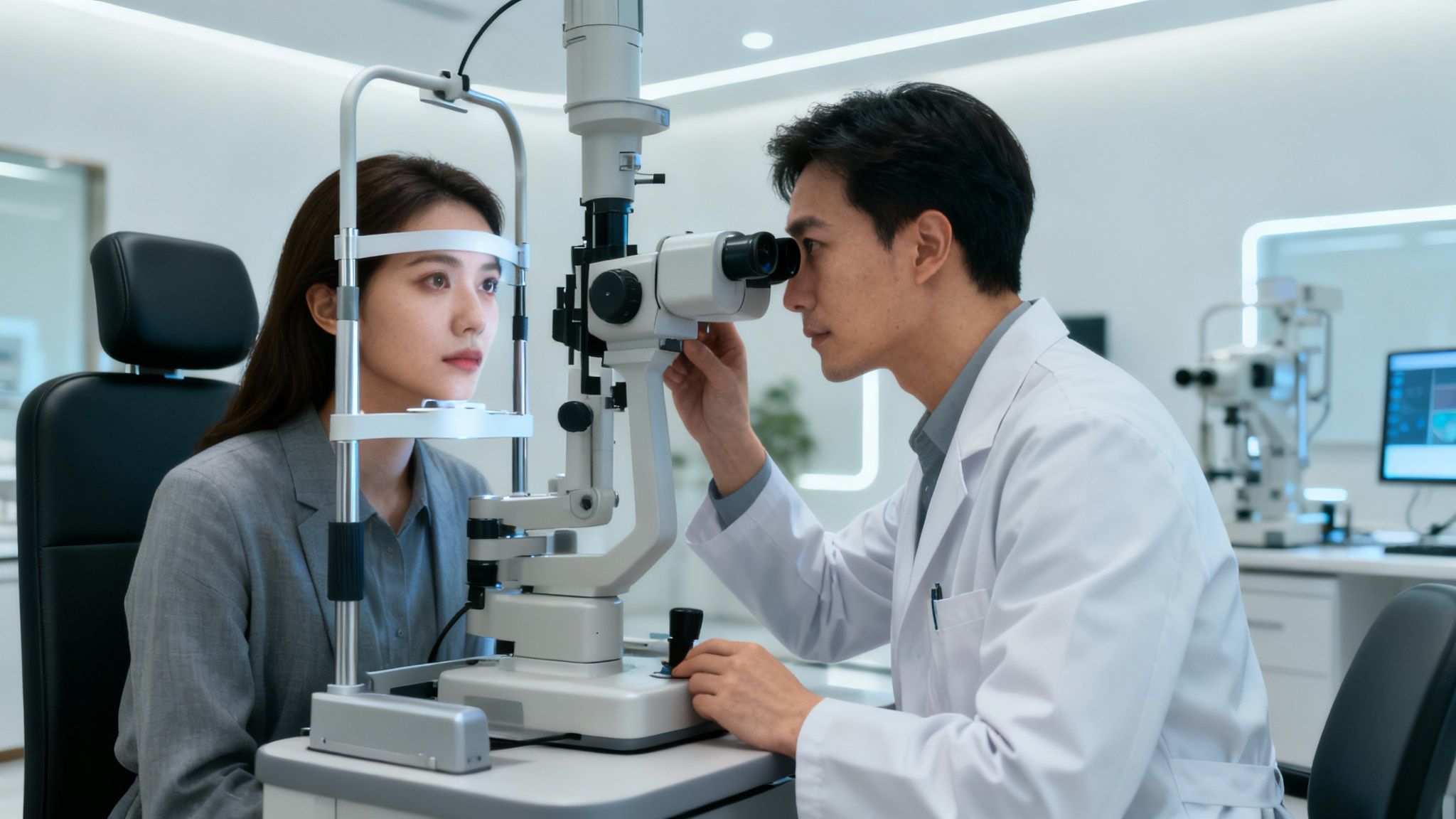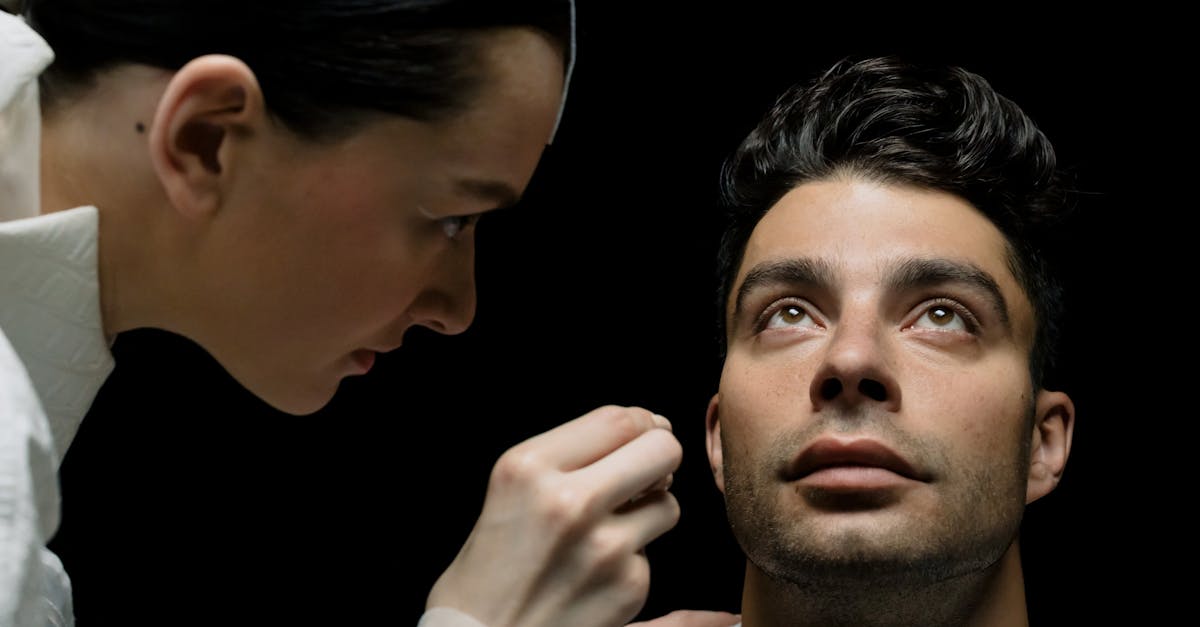Absolutely. If you’ve started noticing it’s harder to read your phone or a menu while living in Glendale Heights, you might think reading glasses are your only option. The good news is, that's not the case anymore.
Bifocal contact lenses are a fantastic, modern way to get clear vision at any distance, freeing you from the on-again, off-again hassle of readers. At iDoctor, our independent optometry boutique in Glendale Heights, we specialize in finding the perfect vision solution that fits your lifestyle.
A Clearer Future Without Reading Glasses
It happens to almost everyone, usually right around age 40. That frustrating moment when your arms suddenly aren't long enough to read a text message. This natural change is called presbyopia, and it’s simply the eye’s lens becoming less flexible over time, making it tough to focus up close.
Thankfully, you don't have to juggle multiple pairs of glasses. Bifocal and multifocal contacts are designed specifically for this exact problem.
These aren't your standard contacts. They cleverly incorporate different prescriptions into one lens to give you clear vision at multiple distances. It’s like having your distance and reading vision corrected all at once, seamlessly. You can go from driving down North Avenue to your office, to reading your work computer, to glancing at a text message without a second thought.
They give you back a sense of visual freedom that's hard to beat. To put this into perspective, let's quickly compare the old-school solution with the modern one.
Bifocal Vision Correction At a Glance
| Feature | Bifocal Glasses | Bifocal Contact Lenses |
|---|---|---|
| Field of View | Limited by the frame; visible line can be distracting. | Provides a natural, full field of view without lines. |
| Convenience | May need to be taken on and off; can be cumbersome. | Wear them all day for seamless vision at all distances. |
| Appearance | Visible "bifocal line" can be an aesthetic concern. | Completely invisible, offering a natural look. |
| Activities | Can be difficult for sports or active lifestyles. | Ideal for active individuals; won't fog up or fall off. |
This side-by-side shows just how much contact lens technology offers a more integrated and flexible solution for managing presbyopia today.
The Growing Demand for Seamless Vision
Bifocal contacts used to be a fairly specialized product, but that's changed completely. As more people look for an alternative to reading glasses that fits an active life, their popularity has soared.
The market for these lenses was valued at around $131 million and is expected to climb to nearly $185 million by 2031. That’s a clear sign that people want vision correction that keeps up with them.
Here at iDoctor, fitting these advanced lenses is one of our specialties. We've seen firsthand how cutting-edge contact lens technology is improving comfort and clarity for all-day wear and changing our patients' lives.
Our whole approach is to find a solution that feels so natural, you forget you're even wearing them—whether you’re enjoying a day at Camera Park or just out to dinner in town. In this guide, we’ll walk through how they work, what your options are, and how our fitting process ensures you get the perfect vision you deserve.
Understanding Presbyopia and Your Changing Vision
So, what’s going on with your eyes? Before we can talk about a fix, it helps to understand the problem. That frustrating blurriness when you try to read your phone has a name: presbyopia. It's not a disease, and you didn't do anything to cause it. It's just a completely natural part of life that usually kicks in around age 40.
Think of the lens inside your eye like the autofocus on a high-end camera. For years, it flexed without you ever thinking about it, instantly shifting focus from the road ahead to the map on your phone.
As we get older, that lens naturally gets a little stiffer. The tiny muscles around it can't bend it as easily as they used to, which makes focusing on things up close a real challenge.
What Does Presbyopia Feel Like?
This gradual change creates those tell-tale signs that many of us start to notice. You might find yourself doing things you never had to do before:
- The "trombone arm": Holding your phone or a menu further and further away to get the text into focus.
- Reaching for more light: Needing to turn on every lamp in the room just to read a book or the fine print on a medicine bottle.
- That tired, strained feeling: Getting headaches or feeling your eyes get fatigued after working on a computer or doing any close-up task.
- Squinting to see a text message after a long day or struggling with the dim lighting at a restaurant in Glendale Heights.
These are all classic clues that your eye's built-in "autofocus" is losing a step. It happens to pretty much everyone, whether you're teeing off at Glendale Lakes Golf Club or watching your kids play at Camera Park.
Presbyopia is a universal part of aging. By age 50, nearly 100% of people will have noticeable symptoms, making it tough to see up close without some help.
Why an Eye Exam Is Your Best First Step
Seeing these signs is the first step, but what's next? It's tempting to just grab a pair of cheap "cheaters" from the drugstore, but that's a generic fix for a very personal issue. Those off-the-rack readers don't correct for other things like astigmatism, and they certainly won't help you see clearly at every distance.
If you're really wondering how to tell if you need bifocals, the only way to get a clear answer is with a professional eye exam.
A comprehensive eye exam here at iDoctor in Glendale Heights does so much more than find your reading power. We'll get your exact prescription for distance, intermediate, and near vision, all while checking on the overall health of your eyes. Having this complete picture is crucial for finding the right solution for you—especially if you're interested in something more advanced like bifocal contact lenses.
How Multifocal Contact Lenses Restore Your Focus
So, you're wondering if there are contacts that work like bifocals. The answer is a resounding yes, but the technology is actually a lot more sophisticated than what you find in bifocal glasses. Today’s lenses are typically multifocal, which means they contain a whole range of prescriptions to give you clear vision up close, far away, and everywhere in between.
But how can one tiny, soft lens manage all of that at the same time? The magic is in a concept called simultaneous vision.
Picture this: you’re sitting on a screened-in porch in Glendale Heights. You can see the fine mesh of the screen right in front of your face, but you can also see the kids playing in the backyard beyond it. Your brain effortlessly chooses which one to focus on and tunes the other one out. Multifocal contacts use that same amazing ability of your brain to work.
The Science Behind Simultaneous Vision
Unlike bifocal glasses with that tell-tale line, these advanced lenses don't have a dedicated "top" for distance and "bottom" for reading. Instead, they use some pretty clever designs to create a seamless visual experience.
The two most common approaches are:
- Concentric Rings: Think of a tiny bullseye on the lens. Some of the rings are powered for distance vision, and the alternating rings are powered for near vision. Light from all distances enters your eye at once, and your brain quickly learns which image to pay attention to.
- Aspheric (Blended) Designs: These lenses have a more gradual, natural shift in power. They might have the near prescription in the very center, which smoothly transitions to the distance prescription toward the outer edges. This blended approach helps make focusing feel more intuitive.
Your brain is the real hero here. It's incredibly adaptable and, after a short adjustment period, it learns to automatically select the clearest image and filter out the blur. Suddenly, you can read a menu and then look up to see a friend across the room without missing a beat.
If you're wondering why this technology is even necessary, this visual guide breaks down what happens to our eyes as we get older.
As the chart shows, presbyopia isn’t a disease—it’s just a natural part of aging where the lens inside our eye becomes less flexible. This is what causes that familiar eye strain when trying to focus on anything up close.
Bifocal vs. Multifocal: What's the Difference?
You’ll often hear people use these terms interchangeably, but there's a key distinction. A true bifocal lens has just two prescription powers. A multifocal lens, on the other hand, has a range of powers to help you with those in-between distances, like looking at your computer screen or the dashboard of your car.
If you want to get into the nitty-gritty, you can learn more about how multifocal contact lenses work in our other guide.
Most of the "bifocal" contacts on the market today are actually multifocal, simply because they offer so much more visual freedom. While these contacts are a game-changer for many, it’s worth noting that the traditional bifocal glasses market was valued at around USD 7.5 billion globally. Part of this is because glasses can be more affordable and easier for some to adapt to, especially considering an estimated 128 million Americans deal with vision issues that need this kind of correction.
Ultimately, whether bifocal or multifocal, the goal is the same: to bring back that easy, effortless focus you used to have. For anyone tired of constantly reaching for their reading glasses, they are a fantastic option to explore.
Finding the Right Bifocal Contact Lenses for You
So, you're thinking about bifocal contacts. The first thing we need to figure out isn't just your prescription, but what your day-to-day life actually looks like. Your lifestyle is the single biggest clue to finding the perfect lens. Here at iDoctor, we'll walk you through the options to find a fit that makes correcting your vision feel completely natural.
We'll start with the lens material itself. Most people—the vast majority, in fact—end up with soft contact lenses. These are made from flexible, water-friendly plastics that feel incredibly comfortable right from day one. They’re super easy to get used to and come in a huge range of designs.
But for some, Rigid Gas Permeable (RGP) lenses are the way to go. These are firmer, smaller lenses that can deliver exceptionally crisp vision, particularly for people with specific types of astigmatism. They do take a bit more time to adapt to, but many of our long-term wearers absolutely swear by them.
Choosing Your Wearing Schedule
Once we've picked a material, we need to decide on a replacement schedule. This is where your personal routine and habits really guide the decision.
- Daily Disposables: These are the ultimate in convenience and are fantastic for eye health. You pop in a fresh, new pair every morning and just toss them out at night. No cleaning, no solutions, no fuss. They’re perfect for busy parents, people who only wear contacts occasionally, or for a clean lens on a day out at the East Branch Forest Preserve.
- Bi-Weekly or Monthly Lenses: If you’re a full-time contact lens wearer, these reusable options are often more cost-effective. They do require a simple cleaning and storing routine each night, but they provide excellent comfort and performance for everyday use.
Choosing the right lens isn’t just about vision; it’s about finding something that clicks with your life. Whether you need the grab-and-go ease of dailies or the reliability of monthlies, we have options here in Glendale Heights to fit how you live.
This gives you a good starting point for thinking about what you need from your contacts. For a deeper dive, check out our complete guide to prescription contact lenses. When you come in for your appointment at iDoctor, we’ll go over all of this together to find the solution that works best for you.
Why an Expert Contact Lens Fitting Is Crucial
If you want to be successful with bifocal contacts, everything hinges on getting a precise, professional fitting. This isn't something you can eyeball online or guesstimate with an old glasses prescription. Your eyes are as unique as your fingerprints, and multifocal lenses demand a far more detailed approach than standard contacts to work properly. A good fit is what ensures your vision is sharp, clear, and comfortable whether you're looking near, far, or in between.
Here at iDoctor, we always start with one of our detailed eye exams in Glendale Heights. But we go way beyond just figuring out your prescription. We use high-resolution imaging to create a detailed map of your cornea's unique shape and curvature. This step is absolutely critical, because bifocal contacts have to sit perfectly centered on your eye to give you that clear, stable vision you’re looking for.
Once we have a clear picture of your ocular health and prescription needs, we’ll talk about your life. Are you staring at a computer screen for hours? An avid reader who loves to curl up with a book? Or maybe you spend a lot of time driving along Bloomingdale Road and need crisp distance vision? Your lifestyle helps us pinpoint the best possible lens design for your specific visual demands.
The Fitting and Trial Period
Let's be real: finding the perfect multifocal lens often takes a bit of trial and error. This is a completely normal and necessary part of the journey. We'll start you off with a set of diagnostic lenses to try out in your everyday life.
This trial period is your chance to see how the lenses perform during a typical day. It’s also important because your brain needs a little time to adapt to this new way of seeing. As you go about your routine, you can jot down notes on what’s working well and what might need a little tweaking.
Think of a professional fitting as a partnership. Your feedback combined with our clinical expertise is the secret sauce for achieving clear, effortless vision with bifocal contacts. Without it, you're often left with blurry vision or discomfort, which just leads to frustration.
Fine-Tuning for a Perfect Fit
This is why follow-up appointments are non-negotiable for a successful fitting. During these visits, we'll check how the lens is sitting on your eye and, more importantly, listen to your real-world experience. From there, we can fine-tune the prescription or even try a different brand or design to get your vision just right. Our goal is simple: to make sure you're completely comfortable and happy.
If you want a deeper dive into what the whole process looks like, check out our guide on what to expect during a contact lens fitting and how to choose the right lenses.
Honestly, skipping this expert-led process is the #1 reason people give up on bifocal contacts. By investing a little time in a proper fitting here in Glendale Heights, you’re giving yourself the best shot at enjoying the incredible freedom these advanced lenses can offer.
Weighing the Pros and Cons of Bifocal Contacts
Making the right choice for your vision means looking at the whole picture. When it comes to bifocal contacts, you're essentially balancing the incredible freedom they offer against a few practical things you'll want to keep in mind.
Let's break it down.
The Upside: What You Stand to Gain
For many people, the freedom from reading glasses is a game-changer. Imagine not having to constantly search for your "cheaters" every time you need to read a menu, a price tag, or a text message. You get a completely natural field of view, with no distracting line cutting across your vision like you'd have with traditional bifocal glasses.
This is a huge plus for anyone with an active lifestyle. Whether you're playing a round at Glendale Lakes Golf Club or just out for a walk, you can do it all without glasses slipping down your nose or fogging up.
- Seamless Vision: You can effortlessly shift your focus from something up close to something far away, almost without thinking about it.
- Aesthetic Freedom: You get the vision correction you need without the visible lines that come with bifocal glasses.
- Active Lifestyle: They're perfect for sports, hobbies, and any activity where glasses just get in the way.
The Other Side: What to Consider
Of course, there are a few things to be aware of. First, there’s an adjustment period. It typically takes about one to two weeks for your brain to fully adapt to this new way of seeing. During this time, it's not uncommon to notice a little bit of glare or some halos around lights, especially at night. For most people, this fades as their eyes get used to the lenses.
It's also worth noting that multifocal contacts are a bigger investment than standard, single-vision lenses. Their complex design and the more detailed, personalized fitting process contribute to the higher cost.
While bifocal contacts solve a ton of everyday vision problems, they don't cover every single need. For example, there’s a growing market for bifocal performance glasses designed for industrial workers who need both presbyopia correction and impact protection. That’s a niche soft contacts just can't fill. You can read more about this specialized eyewear market if you're curious.
At the end of the day, the only way to know for sure if they’re a good fit for you is to try them. A personal consultation at our Glendale Heights boutique lets us dive into your specific vision needs and see if bifocal contacts are the perfect match for your lifestyle.
Frequently Asked Questions in Glendale Heights
Does iDoctor accept my vision insurance for bifocal contacts?
Yes, iDoctor accepts all major vision insurance plans. Bifocal and multifocal contacts are often classified as specialty lenses, so coverage can differ from one plan to another. Our staff in Glendale Heights are pros at navigating insurance and will help you get the most out of your benefits.
How long does it take to get used to multifocal contacts?
It varies, but most people adapt within one to two weeks. It's normal to notice some slight visual quirks at first as your brain learns to work with the different prescription zones. We always schedule follow-up visits to ensure your adjustment is going as smoothly as possible.
Can I get designer eyeglasses at iDoctor too?
Absolutely. While we are experts in fitting contact lenses in Glendale Heights, we also offer a curated collection of luxury eyewear. You can find everything from Cartier and Gucci to more affordable brands like Ray-Ban in our boutique. If contacts aren't the right fit, we have plenty of stylish alternatives.
Are daily disposable bifocal contacts available?
Yes! Daily disposables are a fantastic and increasingly popular choice. They are perfect for people who prioritize convenience and eye health, struggle with seasonal allergies, or want the flexibility of wearing contacts for special occasions without the hassle of cleaning and storage.
Ready to explore a life free from reading glasses? Schedule your comprehensive eye exam with the best optometrist in Glendale Heights at iDoctor. Our team is here to help you see clearly and comfortably at every distance.


